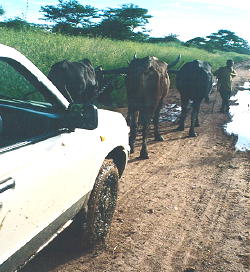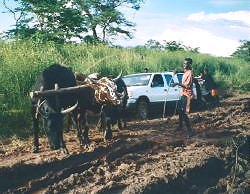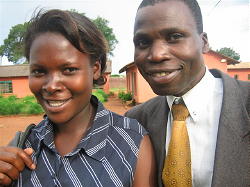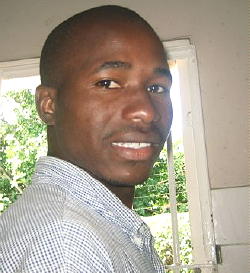Introduction We pleased to report on the activities of LifeNets in Zambia for the year ending 31 December, 2008 Cattle Restoration Project
Oxen that were born from the original twenty two heifers are now
approaching maturity. The draft power from a mature ox is nothing
short of staggering. On my last visit to Nalubanda my Nissan was
once again stuck, deep in the mud.
This year saw the return of the foot and mouth disease in most parts of Zambia. We commend our government because they put in place two intervention measures: They banned stock movement for any and every reason and they put in place a free spray and treatment program. Out of total herd of over one hundred, we lost only two. This mortality rate reflects a commendable dedication to the tick spray program that we put in put in place at the start of this project. People that obey God have done extremely well with this project. For example, Jerry's heifers have produced a total of 8 Calves. On the other hand, Armstrong’s two original heifers are dead and he has only one calf to show, and that, after eight years of hard labor. Back to the story, the balance of the original heifers stood at fifteen as at 31 December, 2008. During the year under review, 19 calves were born. Two were still
births while one died in its first month. This is a 70% calving
rate; though this rate is very good for the area in which work, it
is still far below our expectation.
As explained in last years report, the low fertility rate that we experience is due to the Lumpy Skin Disease that attacked the animals in 2006. We hope that with passage of time, the animals will fully recover from the effects of this disease and return to the high productivity that we enjoyed during the early years of this project. Because of low fertility that we experienced in the last two years, we want to revise our 1st tithe projection from the cattle restoration project. Unless something else goes wrong, by 2010 we hope to get at least four animals as 1st tithe. This is a far cry from the 15 animals that we projected last year. Still, even a tithe of four animals only, equals to 66% increase in 1st tithe. That is not a mean achievement by any standards. Our head now numbers 105 (92 in 2007) valued at K 105 Million Kwacha (92 Million in 2007). This is equivalent to US$ 25,000; This massive increase in stock value comes from only US$ 4,000 invested in 2001. The above valuation excludes 10 animals that were sold to buy Scotch Carts and meet various family needs. The dollar value remains the same due to foreign exchange rate movement. (One US Dollar -- 5275 Zambian Kwachas). Overall the herd is in good shape and we are looking to an even better 2009. Farm credit program
This program continues to deliver short term benefits to our community. We added three more farmers to the program and brought back one farmer from the two that we removed last year. The total amount advanced to finance farming in puts in year ending 2008 was K21 Million (2007 K 16 Million).
Last year was a very bad season. The rains were excessive causing severe flooding in most parts of Zambia. As if that was not enough, the rains stopped in February instead of the usual late March. This means that the growing season too wet and very short.
That not withstanding, our farmers posted an excellent result. This was due to the fact that maize production in the country, including that of our members, was very poor. However; the market price went up from the K 72, 000 to K110, 000, in response to the poor supply side of the equation. The price rise made up for the shortfall in production.
In the year under review, this is what the agriculture credit program delivered:
1) Church contributions from Nalubanda and Kasumpa reached an all time high at K7.720 Million compared to K 6.007 Million in 2007, an increase of 28%. 2) All the households, except one, paid their tithes 3) Only the usual two families requested church assistance, but, that comes as no surprise. Perhaps these are people Jesus Christ referred to when he said “you will always have the poor among you”.
The 2008/9 rainfall pattern, so far, is proving to be the most normal in many years. Most of the days, it rains in the afternoon and at night. Such a rainfall pattern gives the farmers opportunity to work their fields. To date, there are no reports of floods any where in the country.
During my last visit, every field I looked at, the crops, looked better than at anytime since we started working in this area. There is every indication that the country may be headed for a bumper harvest, this is very good. How ever, it is early days yet. We need the rains at least till the middle of March. In these end times, anything is possible, making it extremely important that we look to God to continue to provide us with good rains.
Advances to farmers
Each year our nation enjoys a bumper harvest, one can be more than certain that maize floor prices will collapse if not crush from April to September each year. During this period, brief case business men buy maize from farmers for next to nothing. This year we project that the position will be no different because there has been no changes to the government crop marketing policy.
This is where the Pre Finance Component of the Farm Credit Program comes into play and is critical to the survival and success to our farmers. To recap; come April or May 2009, we will advance participating farmers funds to meet their living expenses.
The advance is to tidy them over during the period when the maize price collapses because the small maize traders cannot buy all the maize that comes on the market during this period.
We take maize as security for these advances. We hold the maize till October or November. When the price is right, we sell the maize, recover our loans and pay the farmer his profit.
The returns to farmer are never less than 40% of the loan taken.
Maize Marketing In 2008 we started, to assist the people that live in the city through the Maize Marketing Project. This project is a run away success. We budgeted to finance seven families, but, we ended up financing eight families to a tune of 17.000 Million Kwacha. To demonstrate the success of this project we reproduce the Accounts of one maize trader, Mrs. Rebecca Chipempele. She applied and received a loan of K 1,100 Million Kwacha. Zambia Kwachas
33 Bags of maize at K27, 000 per 50 Kg Bag 891,000
Empty Grain bags 45,000 Marketing expenses 66,000 Bus fare to Nalubanda etc 50,000 Food etc 50,000 211,000
Total Expenses 1,102,000
Sale Proceeds at K 55, 000 per 50kg 1,815,000
Net Profit 713,000
Net Profit Margin 65%
Budget Margin in the project proposal 58%
By Western standards this business looks like a big waste of time. But before one arrives at such, in our opinion, harsh judgment, it is important to consider the following: a) the
city does not provide any viable business or employment opportunity
There is so much enthusiasm for this project. Consequently, we requested and thankfully were given an additional K 10 Million to expand this project. We plan to increase the amount of the loans to say K 2.200 Million per family and we plan to admit three new entrants to this project. Medical
Medical support is
that component in the package that “Meets the needs of the community
in a practical way.” This aspect of our work has produced wonders. Again, in 2008 for the 7th straight year running, we recorded no deaths among our extended LifeNets family. There are no malnourished children and cases of malaria are again almost none existent. For seven straight years, no still births, no infant mortality, can this be Africa where death is known everywhere? During the year under review, Chisangu and Lloyd suffered serious health set backs. Lloyd has an infection, which, our best medical houses cannot identify and therefore cannot treat. He has been tested for aids three times and each time the test came out negative. He has under gone two surgical operations to remove the infected tissue but this has not helped his situation. This sickness has rendered him unable to work. We lament, because, he was the second most productive farmer on our project. Having tried everything what we know and having spent such colossal sums of something unprecedented in this area, we have now have now resigned. We see the man suffer, but what else can we do? As humans we feel impotent but not hopeless. We only look to God to heal him and God can with the help of your prayers. This life can get extremely cruel. Another man in similar predicament is Chisangu. He has been diagnosed with soft tissue sarcoma a kind of cancer. He is undergoing Chemotherapy at the University teaching hospital. We regret to report that at this stage, there appears to be no improvement. The state of his health is not encouraging. To both these causes, LifeNets contributed US$ 2,000 for which we are most grateful. This amount is in addition to the annual donation of drugs and vitamins that we receive every year. Training
A number of Development study papers, have, over the past many years demonstrated that hard work and money are not in themselves a panacea to the problem of poverty. There is another important ingredient called education.
Early in the life of the project, we understood the importance of the above mix. It is this understanding that motivates us to allocate resources to pay experts in disciplines like; Cattle Rearing, Crop production and Health Care. These government employees are educated, talented and willing to provide extension services to communities, but our government lacks the resources to send them out. We are sure privileged
During the year under review, in addition the local education effort, we hosted Jennifer Myers from LifeNets. She is a financial expert from the United States. She visited Malawi and Zambia to teach a class on the basics of business management. In Zambia she delivered lectures in Lusaka, Kasumpa, Nalubanda and Mapoko. The feed back from the participants that attended the classes was very positive.
Wells
During the year under review, LifeNets dug and equipped two additional wells at the new feast site in Lusaka. Before the feast, we tested both wells. When we tested the wells, the water yield appeared as if it would be more than enough to meet our requirement for the whole eight day period of the feast. We were disappointed; the wells ran dry on the second day of the feast. The contractor made a representation to us that each well would yield a minimum of 5,000 liters daily. This guarantee was in writing. Armed with this assurance, we held meeting with him. At this meeting, he undertook to deepen the wells after the rain season. The hand dug wells are only a stop gap measure. To provide water borne toilets and showers to 300 people, we need water far in excess of 10,000 liters a day. We hope, funds permitting, to engage a contractor who owns a drilling rig to come and bore two wells on our property. The cost of drilling and equipping the two wells plus a simple water reticulation system was US$ 21, 000 when we checked in July 2008. To us this sum of money seems out of this world. Transport
The Nissan Truck
As we reported last in 2007, the Engine in this vehicle was indeed tired. We are extremely pleased to report that we received quick response from the management of LifeNets. They donated US$ 1,600 to buy a second hand engine imported from Japan. We bought and installed the engine in the Nissan. We completed the work late December, 2008. The vendor gave us one month to test Engine, if we are satisfied; the agreement demands that we pay the balance at the end of January 2009. So far the engine is running well. We have driven the Nissan to Kitwe and back, that is a distance of about 1,000 Kilometers. We hoped that this engine can deliver another 200,000 kilometers out of a US$ 1,600 investment. We eagerly await the end of January to consummate the deal, pay the vendor get the paper work from him and register our ownership of Engine with government authorities. The Mitsubishi Canter The Mitsubishi Canter is running well. The body and the vehicle interior are in very good shape. The suspension, steering, electrical systems, the gear box, drive components, the exhaust system etc are all in good working order.
However, we have a problem with the trailer. Though the trailer frame work is made of steel the floor is made of timber. Much shaking and bumping on our dirty roads plus a beating from rain means that the timber on the trailer floor is rotten. It gave way on more than one occasion during the course of the year. Once incident comes to mind. Just like it happened to Fine Makomba at the end of the feast, Lyons Ngwenya, a member in the Lusaka Church lifted his son and “sat” him in the trailer. To our utter shock and dismay, we heard a child crying under the truck. Peeping, we saw the boy, tears streaming from in his red eyes, down his cheeks; he was wearing a big fright on his face. The rotten timber gave way and the boy fell to the ground, fortunately, apart from the shock, he was not badly hurt.
To prevent incidents like the one above, we plan to remove the timber from the truck bed and replace it with a steel floor. Funds permitting we would wish to put a canopy on this truck to prevent passengers that ride in the trailer from getting socked when it rains. We did not include this expenditure in the budget. To underscore the value of this truck to us, we said this before and we will say it again. Two days into the feast, the two wells at the feast site ran dry. We were so grateful to God that the management of LifeNets donated a truck which we used to cart 7,500 liters of water from 10 Kilometers away. Without the truck, we would have had no choice but close the feast site. This underscores the importance of this asset Scholarships During the year ending 31 December, 2008, three young men and one girl benefited from the scholarship program.
Bervin Momba and Sylvester are doing the final year of their diploma courses in Insurance and IT. Bevin was the President of our United Youth Club in 2008. The Job market in Zambia is extremely tight. During the year ending 31 December, 2008, the copper price tumbled from US$ 9,000 a ton to a miserable US$ 3,500 a ton. At this price the copper mines claim that it is not economical to mine and process copper. Three mining houses went out of business at the end of last year throwing multiple thousands of workers on the street. All things being equal, the chances of these young men getting a job this year are next to nothing. But, there is a God in heaven, we believe that he can not allow the investment we have made and continue to make in these young people go to waste.
Gideon wrote his examination at the end of the term, the result will only come late January 2009. Zere, the girl at the University of Zambia is in her second semester of the first year. This semester will end in April 2009. She is doing well and is a valuable member and treasurer of our United Youth Club. There is a new fellow called Isaac Chipempele that we want to take on board. He is the son one Mrs. Rebecca Chipempele; Rebecca is a long standing and faithful widow in our church. She is the lady whose accounts are reproduced in the Maize Marketing Trade section of this report From his mock examination results, this young man shows a lot of promise. Caution never hurts, until we sight his final high school results, we will not commit ourselves to him. Since he plans to study Medicine at the University of Zambia, this may prove to be the longest financial commitment that we may make in Zambia. Management From this report it does not take a lot of imagination to conclude that the activities of LifeNets in Zambia have expanded to a point where it is difficult for Shirley and I to cope. Fortunately there are a number of men that work with us. Haben Moonga continues to be our point man in Nalubanda and Kasumpa and we have appointed Ephraim Mwashi in Mapoko. These men are dedicated. They have demonstrated their dedication by their willingness to sacrifice their time. They are very helpful -- both to us and the project. They are in close proximity to the farmers. As a minimum, they meet farmers at least once a week. No man lasts for ever, it is my view that it is important to start thinking and working on a succession plan. What a better way to start than with people that you work with, know well and have come to trust. Lest I be misunderstood, let me say upfront that, I am not going anywhere. I am committed to this project for the forseable future. Still on the subject of staffing, it would be remiss of us if we do not acknowledge the invaluable help that we receive from Jerry and his wife Nice. Jerry handles all the day to day finances and the administrative issues that arise in these far away areas. As a token of Appreciation we gave Haben K200, 000 to repair his bicycle. We propose to give Ephraim a similar amount Budget and Financial Statements
We attach the Financial Statements for Year ending 31 December, 2008. Although we already submitted our budget for the period to 31 December, 2009 amounting to US$ 18735, we resubmit the same to ensure that this report is a stand alone document.
The salient features of the budget for 12 Months ending 31 December, 2008 are as follows: US$ Scholarships 10,000 Total 18,735
The increase in the operating expenses is due to the down ward revision of the exchange rate and a provision for bicycles spares for the men that help us supervise the project. Thank you very much for approving and funding our budget.
Financial Statements
Receipts K’000 Funding from LifeNets 75, 026 Payments Advances to Farmers 5 1, 996
Notes to the Financial Statements
Motor Vehicle expenses
Motor vehicle expenses comprise of insurance and the cost of the Nissan Truck Engine as discussed in the transport section of the report.
Scholarships Only 18.000 Million Kwacha was spent in the year under review, the balance in the scholarship fund account represent amounts due to Zere and Gidion. They will draw their dues at the beginning of 2009. Health Support This sum was spent on the medical treatment for Llyod and Chisangu
Visitors Expenses This amount was spent on petrol, accommodation and food for Miss Jennifer Myers. Mapoko Cattle Restoration project
Of the original Head of cattle we bought, one heifer, one ox and the only bull died during the year ending 31 December, 2008. The heifer died because the farmer received wrong advice from the government Veterinary Officer. This heifer produced a still born calf and the placenta was failing to come out her. Ephraim reported to us that a veterinary officer advised (this is still sends a chill in my back) the farmer to forcibly pull the placenta to remove it from the heifer. When the farmer forcibly pulled the placenta, the animal bled to death. The ox died because it was abused by farmer using it. This man is a problem and refused to cooperate with our man, Ephraim Mwashi. When called, he did not come to two meetings that I attended. As a result, we had no choice but to cancel his membership to LifeNets and reposes the heifers from him. I understand from Ephraim that the bull was bitten by a swarm of bees and died. As a bull is a pivotal component to the success of this program, plans are under way to replace it. Please ratify this purchase. Compared to Nalubanda, it appears that the cattle restoration project in Mapoko has got off to a bumpy start. How ever, I believe that, except for one case, we are dealing with a group of people that are a victim of time and chance. I am hopeful. We will salvage something from this project. We are looking to June 2009 when we should be able to report some good news. By then, we hope that the heifers will drop the first batch of calves. Farm Credit Program
We are pleased to report that all the families that benefited from this program repaid their loans and made a profit.
The encouraging results from the 2007/2008 season and in keeping with our promise, we increased funding in this sector. This is the investment that we made in the Mapoko Farm Credit Program
K’000
Farm Implements 4.400 Farm Credit Program 14,330
Total Investment 18,730
The farmers will get a big benefit when we pre finance their crop in May to October 2009. Instead of repeating the operation of the pre finance component of the Farm Credit Program, we send you to the section dealing with Advances to Farmers section of this report. Mapoko is in the same general area of Nalubanda, the rain is normal this year and the crops looked good during my last visit. Like in Nalubanda we pray that this rain pattern continues till the middle or end of March 2009 Financial Statements – Mapoko project The financial statements for 20 Months to 31 December, 2008 are attached. The salient features are as follows Receipts K’000
Funding from LifeNets 77,665 Loan repayments from farmers 11,530
Payments
Advances to Farmers 36, 725 Cattle stock 18, 100 Farming Equipment 8, 612 Motor vehicle Expenses 2, 518 Project Supervision 2, 500
Notes to the Accounts
Motor Vehicle
Expenses Motor vehicles is a share of the cost of running the two Motor Vehicles between the LifeNets and the church
Project Supervision This is the amount spent on food and drinks during open days; the cost of transporting and paying allowances to local agriculture, cooperative and livestock officers and maintaining two bicycles which belong to the project supervisors Conclusion
Overall, in 2008 Nalubanda, LifeNets has again made huge progress to “meet the needs of the people in practical way and helped to make the families that we work with us to be self sufficient.”
In Mapoko the Cattle Restoration Project is experiencing teething problems but we are confident that this project will stabilize and begin to deliver. Since, the Farm Credit program is on course, it gives us reason to believe that the cattle restoration project in Mapoko will work.
We look to the
coming year with a great deal of excitement. Again thank very much
in giving the opportunity to help a people practice the way of God
and leave the poverty behind.
|
|||||||
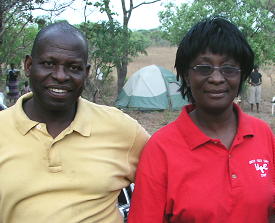
 LifeNets
in Zambia
LifeNets
in Zambia Twelve strong men failed to push
it out of the mud.
Twelve strong men failed to push
it out of the mud.
